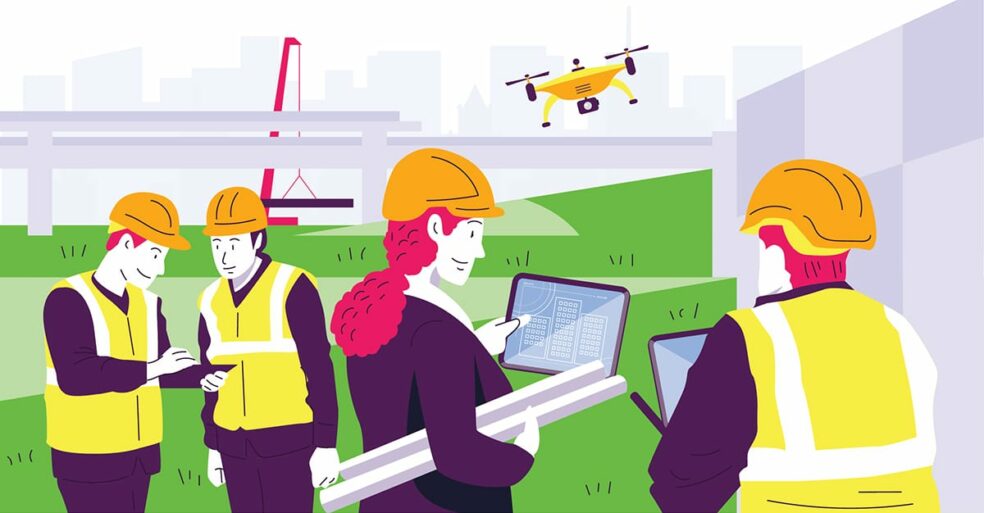When it comes to employee engagement and software, often times the focus is on the corporate locations. You know, the places where people have offices or are sitting at a desk for the majority of their workday.
And while unintentional, it’s easy to neglect technologies and the ways to keep the deskless workforce engaged, even though they make about 80% of how people are working today.
As a colleague once said to me at a previous workplace, “You have a dedicated desk? How 20th century.”
Organizations are catching on that there is a disconnect between deskless employees and the headquarters.
A large part is due to the influx of remote work, which has spiked in popularity in recent years but was already becoming increasingly prevalent and decentralized even before COVID-19.
Below I’ll explore more about the deskless workforce and how to better engage them to improve communication, productivity, and collaboration.
- Who Is the Deskless Workforce?
- Data Around Deskless Employees
- How to Better Engage Deskless Employees
- Using Employee Advocacy for Deskless Employees
Who is the Deskless Workforce?
As alluded to in the intro, the deskless workforce is anyone who is not sitting at a desk all day within one of the company locations.
This can include HQ employees whose routine is mostly mobile, like an office management associate who is on the go throughout the building on a daily basis.
But, the term deskless workforce can also extend to remote workers now, because they are siloed away from the company in their own homes.
And the deskless workforce can include a plethora of industries and job titles. Think retail stores, healthcare, construction, transportation, etc.
It’s easy for these groups of people to feel disconnected from their company and other colleagues beyond the team they communicate with daily.
Not having a desk nearby everyone else can lead to confusion about what is going on in the company, perhaps feelings of being under-appreciated, ideas and accomplishments from the frontlines going unnoticed, etc.
And for the deskless workers on the go, mobile communications and software will be key to staying informed, connected, and engaged.
While remote workers will benefit from mobile, they are most likely working from a desk and computer — either way they need to still feel like a valued member of their company.
Data Around Deskless Employees
While there are some statistics around the deskless workforce, surprisingly there is not much information that is readily available. Because this issue has only begun being investigated, the insights are not as obvious as other areas of business.
However, after a detailed search I was able to find some really interesting data points around the deskless workforce. Below are just a few that really stood out.
- 86% of employees feel connected to their direct co-workers but only 14% feel connected to their business HQ. And just 3% feel connected to their C-Suite. (source)
- There are over 2.7 billion people in all industries from agriculture to healthcare to restaurants deskless employees. And of the $300 billion business technology market, only $3 billion is directed towards the deskless. (Source)
- 83% of managers claim they give all their employees a voice, however 54% claim they feel voiceless. (Source)
- 95% of business leaders recognize the value of collaboration tools but only 56% have them rolled out. (Source)
- 52% deskless employees surveyed said that communicating with employees is either somewhat challenging or very challenging. (Source)
If your organization has a large influx of deskless employees or if you run a team that works in that way, have you thought about how informed or connected they feel? Do they have access to the right tools and technology to better align with their teammates, departments, executives, and company as a whole?
It’s important to analyze those questions and you might even want to survey the deskless crew of employees to get honest feedback about how they feel working away from headquarters.
How to Better Engage Deskless Employees
If your workforce is made up of employees on the frontlines, undoubtedly you need to keep them happy, feeling connected to the company mission and values, and being able to keep them in the loop of company news.
By getting your deskless employees more engaged, you’ll find communication improving, productivity and motivation increasing, less confusion or back and forth, more innovation and insights, and a work environment where everyone feels like they belong to the company culture.
Happier employees who feel valued and heard will only lead to beneficial outcomes for your company. But how can you start to better engage deskless employees?
Increase participation from deskless employees
Because deskless employees and frontline workers can feel siloed away from corporate HQ, make it a key part of your strategy to ensure the frontline teams feel included in important company news and conversations.
That means any company initiatives, programs, and company information should be readily available for deskless teams.
Vocational efficacy, or the sense that one’s work in a company has a positive effect and that one trusts the brand’s mission is all imperative for frontline workers to stay tenured and to do their best.
This should be stating the obvious, but it’s easy for organizations to lack proper coordination with teams who are not at stationary desks or who are on the move for their jobs.
Survey the deskless teams
While it’s important to gauge feedback and insights from all your company employees, you might want to consider a separate and specific one for the deskless workers.
Their needs and feedback can greatly differ from employees working in the office.
Insights gleaned from a deskless-specific survey can tell you if your company is lacking support for such workers, if there are specific initiatives that could help deskless employees feel like they belong to the company community, in addition to general feedback and ideas, etc.
It’s better to have accurate information from the source, instead of guessing what the needs are of your frontline teams, consequently wasting time that could be resolved with data.
Employee recognition
Another important tip when it comes to engaging the deskless workforce is to improve your employee recognition process.
Again, this is something that applies to your entire organization, but ensure that employees who are not in the main offices are still valued, recognized, appreciated, and rewarded for their work and ideas.
82% of employed Americans don’t feel that their supervisors recognize them enough for their contributions. That’s a huge percentage and it greatly affects productivity, employee retention, and overall work happiness.
Your deskless workers have unique experiences, insights, and value to your company — show them off to everyone in the company and publicly recognize their contributions and knowledge.
Technology
While too much technology can cause noise and distractions, your organization absolutely needs to have vital software that will keep employees productive, informed, and connected.
There are many desktop technology solutions that make it easier for your organization to solve challenges, get information to team members, keep track of different job progress, and more.
However with deskless workers, it’s not always easy for them to access information or use technology, which is where mobile plays a major role.
Most communication tools or marketing software will have a mobile app or version, which is perfect for deskless workers or frontline employees.
Technology like Slack for instant messaging and communications, Zoom for video conferencing and meetings, HR software, and others streamline their products via mobile.
Employee Advocacy Software for Deskless Employees
In the previous section, I mentioned that technology is a key aspect to better engage the deskless workforce.
In fact, there are a few options and collaboration tools that can help ensure that all employees are engaged, informed, and communicating with each other.
Yet, one piece of technology that can have a profound impact on engagement especially for your deskless workforce but also for corporate teams such as sales, marketing, and HR is employee advocacy software.
Admittedly, I’m biased as the head of marketing for EveryoneSocial, but the value is evident and I want to explain how.
EveryoneSocial is used to keep employees informed, creating, and sharing — wherever they are working.
When I say everyone, I mean everyone: from employees at their desks and at corporate offices, to remote and distributed teams, to those working on the frontlines — they can all have a platform and mobile access and will feel connected to other teams in one application.
EveryoneSocial
There is plenty to cover on how EveryoneSocial can be used for retail and deskless employees, but here are some quick highlights:
- Deskless employees can quickly share successes and customer relationship stories for everyone to learn from — directly from the EveryoneSocial mobile app.
- The frontline workforce can now share their skills within the company, and by sharing externally, become ambassadors.
- EveryoneSocial gives everyone in your organization the ability to connect and engage around announcements and news.
- Give your people the resources they want, delivered when and how they want them (via their mobile phone).
- Compelling stories can come from every corner of your organization, which is why EveryoneSocial includes powerful and simple tools for your people to submit content they create and discover.
- With off the grid employees sharing updates, less time is spent speculating about oversight and everyone can focus their attention on what’s most impactful.
- Deskless workers can easily share inspiring, personal experiences — by far some of the most captivating and successful content — via the EveryoneSocial mobile app.
- Officially keep all your people in the fold and properly provisioned with EveryoneSocial, regardless if they have a company email or not!
And while employee advocacy can be about empowering your deskless workers, it’s just as central to the future of marketing, brand awareness, sales, recruiting, employer branding, and employee communications.
Everyone has a social media network, so it’s time for your employees to make the most of it for their brand and careers.
If you’d like to learn more about employee advocacy, you can dive into some of the resources below. Or if you are intrigued and want to schedule a demo, you can do so here.
















